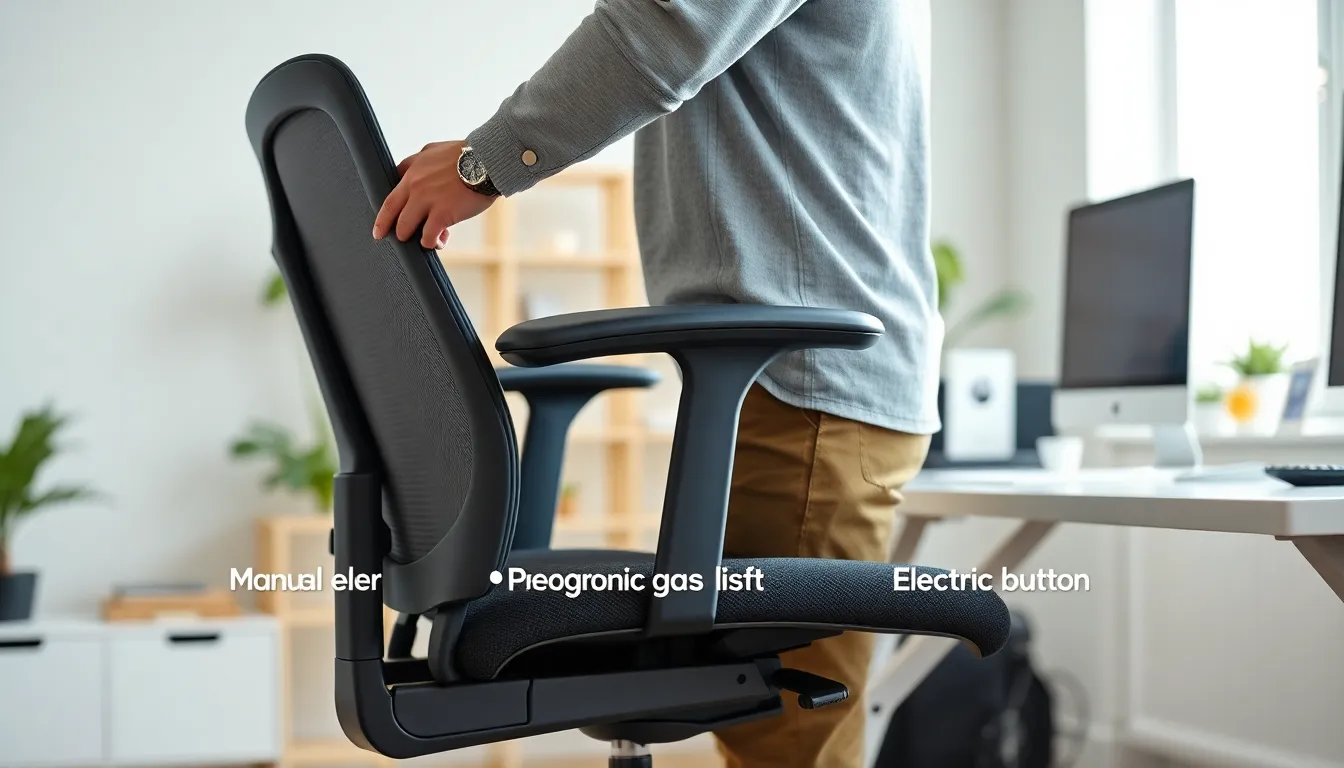Finding the perfect chair height might seem like a trivial task, but it can make or break your work-from-home experience. Picture this: you’re hunched over your desk like a pretzel, trying to type while your legs scream for mercy. Adjusting your chair height isn’t just about comfort; it’s about saving your sanity and keeping your productivity levels soaring.
Table of Contents
ToggleImportance Of Chair Height Adjustment
Chair height adjustment plays a crucial role in ensuring comfort and productivity during work. Properly adjusted chairs can lead to better ergonomics and improved posture, ultimately enhancing overall well-being.
Ergonomics And Comfort
Addressing chair height leads to greater ergonomic benefits. Adjusted chairs align properly with desk height, preventing strain on the neck and back. Customizing chair height allows feet to rest flat on the ground, promoting blood circulation. Reaching surfaces becomes easier, reducing the likelihood of repetitive strain injuries. When chairs fit correctly, individuals experience less discomfort over prolonged periods, resulting in a more pleasant work environment.
Posture Improvement
Correct chair height significantly enhances posture. Sitting at the ideal height fosters a neutral spine position and reduces slouching. When the seat height matches an individual’s leg length, it supports lumbar curvature, enhancing spinal alignment. Clear visibility of the computer screen improves without tilting the neck. With better posture, energy levels often increase, promoting sustained focus and productivity throughout the workday.
Types Of Chair Height Adjustment Mechanisms

Chair height adjustment mechanisms vary, providing options that cater to different user needs. Understanding these methods aids in selecting the right chair for optimal comfort and productivity.
Manual Adjustments
Manual adjustments allow users to modify chair height using physical mechanisms. Users typically find levers or knobs that facilitate height changes. This method requires minimal hardware but offers reliable functionality. Chairs with these mechanisms often appeal to those valuing simplicity and direct control. Some manual adjustments include removable pins or screws, which enhance stability when seated.
Pneumatic Adjustments
Pneumatic adjustments utilize gas cylinders for effortless height changes. A lever conveniently activates the mechanism, making it easy to raise or lower the chair. This system provides smooth transitions and precise positioning, suitable for various user preferences. Many ergonomic chairs incorporate pneumatic systems, ensuring a comfortable fit for diverse body types. Pressure maintains the seat’s height, allowing for quick adjustments without disrupting workflow.
Electric Adjustments
Electric adjustments offer advanced technology for height modification. Users control these chairs through buttons or touchpads, providing seamless adjustments. Electric mechanisms often allow for programmable settings, enhancing convenience and personalization. Ideal for users with mobility concerns, these chairs minimize physical effort. Additionally, electric options may include features like memory settings, recalling preferred heights for different users.
Factors To Consider When Adjusting Chair Height
Adjusting chair height involves several important factors that contribute to overall comfort and productivity. Understanding these elements makes it easier to find the optimal chair position.
User Height
User height directly influences chair height adjustment. A tall individual may require a higher seating position to ensure their feet rest flat on the ground, promoting better circulation. Conversely, shorter users benefit from lower chair settings to maintain proper posture. Ensuring the user’s eye level aligns with the computer screen enhances visual comfort and reduces neck strain. When the chair’s height matches individual needs, it supports a neutral spine and optimal ergonomic position.
Desk Height
Desk height plays a crucial role in determining chair height. Users should align their elbows at approximately a 90-degree angle when seated and positioned at the desk. Chairs adjusted to desk height facilitate natural arm movement, reducing shoulder tension and promoting effective typing posture. If the desk is too high, users may find themselves straining their neck and arms, while a desk that is too low causes slouching. Achieving the right height balance between the chair and desk fosters a comfortable work environment.
Chair Design
Chair design significantly impacts the ease of height adjustment. Different adjustment mechanisms suit various preferences and needs. Manual levers offer straightforward modifications, while pneumatic systems enable quick and smooth adjustments for diverse body types. Electric chairs provide advanced features, allowing users to set preferred heights with the press of a button, benefiting individuals with mobility challenges. Selecting a chair design that accommodates height adjustments effectively enhances sitting posture and overall comfort during long work hours.
Benefits Of Proper Chair Height Adjustment
Proper chair height adjustment leads to multiple benefits that enhance work quality and health. Optimally adjusted chairs facilitate comfortable postures, which contribute to higher productivity levels.
Enhanced Productivity
Adjusting chair height enhances productivity by allowing users to focus on tasks without discomfort. Individuals seated at the right height can easily reach keyboards and screens, minimizing awkward movements. Maintaining an ergonomic position aids efficient typing and reduces fatigue. Workers become more engaged in their tasks when they experience less strain. Studies indicate that proper chair height correlates with improved output, demonstrating the vital role of adjustments in the workplace.
Reduced Physical Strain
Reduced physical strain comes from maintaining a proper chair height, which prevents discomfort and injuries. When chairs align with desk height, users avoid tension in their necks and backs. Natural spinal alignment is achievable when feet rest flat on the ground, promoting blood circulation. Eliminating stress on body muscles leads to decreased fatigue during long hours. Research shows that proper chair adjustment significantly lowers the risk of repetitive strain injuries, allowing for a healthier work routine.
Common Mistakes In Chair Height Adjustment
Chair height adjustment plays a crucial role in comfort and productivity. Common mistakes in this area can lead to discomfort and decreased efficiency.
Underestimating Importance
Many people overlook the significance of proper chair height. Neglecting this factor can result in poor posture, leading to long-term health issues. A chair that’s too high or too low creates strain on the neck and back, affecting overall well-being. Evidence suggests chair height affects spinal alignment and circulation. Adjusting the chair to fit body proportions promotes comfort during extended hours of work. Prioritizing correct height adjustment contributes to a healthier work environment.
Ignoring Individual Preferences
Ignoring personal preferences during height adjustment often causes discomfort. Each person has unique body dimensions and preferences that influence optimal height settings. One individual’s ideal adjustment may differ significantly from another’s. Customizing the chair ensures proper alignment with the desk, allowing for a relaxed typing position. Ergonomic standards vary, making it essential to consider individual needs when making adjustments. Taking individual differences into account promotes enhanced productivity and reduces the risk of injury.
Finding the right chair height is essential for creating a comfortable and productive workspace. Proper adjustments not only enhance posture but also contribute to overall well-being by reducing the risk of discomfort and injuries.
Understanding the various adjustment mechanisms can help individuals select a chair that best suits their needs. By considering personal height and desk dimensions, users can achieve optimal alignment that promotes effective work habits.
Investing time in chair height adjustment pays off in increased energy levels and sustained focus throughout the workday. Prioritizing this simple yet crucial aspect of ergonomic setup can lead to a healthier and more enjoyable work-from-home experience.



